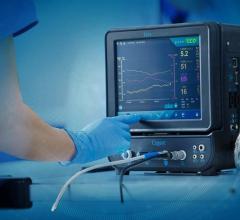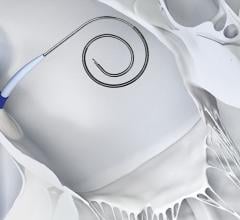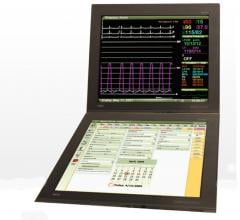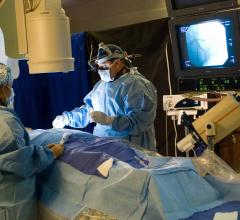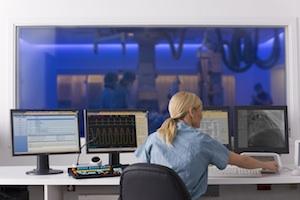
Today’s generation of cath lab hemodynamic recording systems do much more than simply measure and monitor a patient’s electrocardiogram, blood pressure and other vital signs. Current systems offer detailed clinical reporting and auto-completion of data fields in the procedure report, help gather registry data, aid in tracking inventory and patient billing, and link images and cine loops to reports.
Hemodynamic monitoring systems directly measure blood pressure from inside the veins, heart and arteries. They also measure blood flow and how much oxygen is in the blood. In addition, these systems have interfaces to help document diagnostic catheterizations, coronary, peripheral and electrophysiology (EP) procedures. This may include charting, device usage, specific site identification, fractional flow reserve (FFR), sheath exchanges, and automatic timers to record balloon inflation time and pressures applied. The data gathered by the system helps speed workflow by automatically generating reports and auto-fills report fields and billing information. Interfaces also display and record waveforms. Many features of these systems can be customized to each cath lab’s needs. Most also contain a coronary tree diagram for procedure documentation.
Structured Reporting Aids Automation
Cardiology is moving away from dictation to structured reporting so information can be easily transferred into data fields and various registries, said Sonja Holt, RN, BSN, cardiology PACS administrator at Houston Northwest Medical Center in Houston, Texas. She explained that some registries require 250 fields of data for each patient case, so automation is essential. Also, she said electronic medical records with structured reporting will soon be required for reimbursement from Medicare.
“Hospitals are moving away from dictated reports to structured reports, because you can’t mine information from a dictated report,” said Lee Harrop, Merge Healthcare’s director of cardiology product management. He said unstructured free-text and dictation lack the consistency to allow detailed searches of large numbers of patient records. Data being mined, sometimes years later, can shed light on average procedure times, rare complications, workflow efficiencies or better patient outcomes realized when using certain types of interventional devices or techniques.
Workflow Efficiency
Holt said a key factor when evaluating hemo systems should be the organization of nursing notes and ease of use. “It has to provide for nurses – your primary person doing the documentation. It has to be easy to use and match a nurse’s workflow. Nurses cannot be taking time away from a patient case to navigate the software,” she explained.
A hemo system also needs a smooth workflow for physicians so they can quickly enter reports. “You can only get a physician to sit down in front of a computer for a short time,” she said.
Systems should also have workflows or technology to save time, Harrop said. Rather than manually typing all the data, he said touchscreen and use of mouse input actions help speed report completion.
Some systems offer inventory controls using a barcode scanning system. Inventory levels can be set so when an item drops below a certain number, it flags the item for re-order. Standard kits of disposables can also be set up so one barcode records inventory and billing for a set of commonly used disposables, Harrop said.
Other workflow efficiencies may include bi-directional communication with the X-ray angiography system to record still and cine images, or access to picture archiving and communications systems (PACS) to call up historical images, including computed tomography (CT), magnetic resonance (MR), ultrasound or electrocardiograph (ECG) waveforms. With the growing importance of recording fractional flow reserve (FFR) to show a need to stent vessels, hemodynamic systems should also offer FFR integration.
Hemo systems can speed workflow by auto-populating fields in the physician report, which may be tied to an external cardiovascular information system (CVIS). To help speed case reporting, some systems allow multiple users to enter data for a specific procedure at the same time. The system can also track these changes and note which user entered specific information.
As with PACS, hemo systems are moving away from the use of dedicated workstations to allow physicians the freedom to finish reports from any Web-enabled computer.
Advice When Purchasing Systems
When considering a new hemo system, Holt said key factors are workflow efficiencies, structured reporting, compatibility with legacy systems or equipment and cost effectiveness for the facility. In addition, buyers need to verify all the information provided by sales representatives.
“You need to be pretty savvy when you are working with vendor sales reps,” Holt explained.
She said most reps may understand the front end of their systems and what clinicians need, but are not IT engineers, so they do not understand the programming required. The biggest issues usually involve interfacing the hemo system with numerous other IT components, including ordering, nursing reports, charge capture and the hospital information system (HIS). This is especially true of system features that are still in development and have not yet been implemented in the field.
In some cases, Holt said additional technology might be needed to interface the hemo system with other systems, which may add unexpected costs.
Harrop suggests systems should be able to support the needs of various specialties using the cath lab. “We are starting to see a lot more vascular and interventional radiology procedures in the cath lab,” he said. In addition, hemo systems might be used to record electrophysiology (EP) and neurovascular procedures.
Systems Available on the U.S. Market
Philips offers Xper IM Physiomonitoring 5 to complement its Allura cath lab. It monitors vital signs, analyzes hemodynamic parameters, helps with calculations and documents procedures at the point-of-care. Philips said the system reduces the amount of manually entered data. It also documents medication, events, staff and inventory and can be integrated with a barcode reader.
GE Healthcare’s MacLab features a bi-directional interface with the angiography X-ray system, image capture, connectivity to holding-area bedside monitors, ST segment analysis window and admission-discharge-transfer (ADT) interface. Using GE’s Xi2 Data Management System, the system can interface scheduling, billing, statistics and inventory recording. Marquette Medical Systems originally developed MacLab, and it was acquired by GE in 1998.
McKesson’s Horizon Cardiology Hemo integrates patient demographics, clinical hemodynamic data and waveforms, cardiac images and procedural information into a complete patient record, eliminating repetitive data entry. The system uses a low-cost interface device to integrate FFR measurements. It is available as a stand-alone application or integrated into the Horizon Cardiology cardiovascular information solution (CVIS).
The Siemens Axiom Sensis XP system adapts to the user’s workflow with customizable workflow and new advanced measurement functions. It combines both electrophysiology and hemodynamics into one system for a seamless integration with Siemens’ Artis zee angiography systems. For EP, Sensis integrates with the Carto XP mapping system.
Merge Cardio, formerly Camtronics’ Vericis, integrates data from different sites and different sources to create a comprehensive digital record of the patient. At any time and from anywhere, physicians can have instant access to the patient’s complete, up-to-date cardiac file. The Web-based clinical reporting system improves cardiac patient management by streamlining the report generation and distribution process.
Mennen Medical’s Horizon XVu combines user-friendly windows and an intuitive graphic interface. It enables various layouts to suit both cardiac and peripheral procedures. It works with Mennen’s rail-mounted CFE front-end vital signs monitor. In addition, the CFE features an Integrated EtCO2 module and six intracardiac channels for EP studies.
Comparison Chart
This story ran as an introduction to a comparison chart for cath lab hemodynamic systems. The chart can be accessed by clicking on the comparison chart tab at the top of the page. Participants in the chart include:
• GE Healthcare
• McKesson
• Mennen Medical
• Merge Healthcare
• Philips
• Siemens Healthcare


 November 14, 2023
November 14, 2023 
